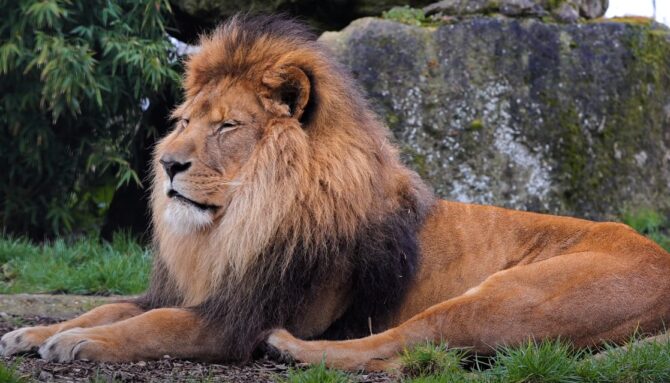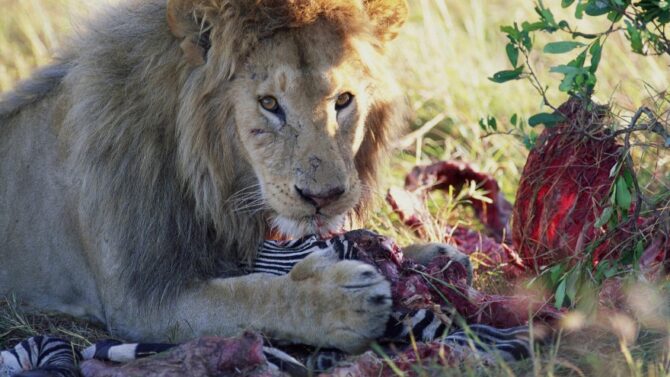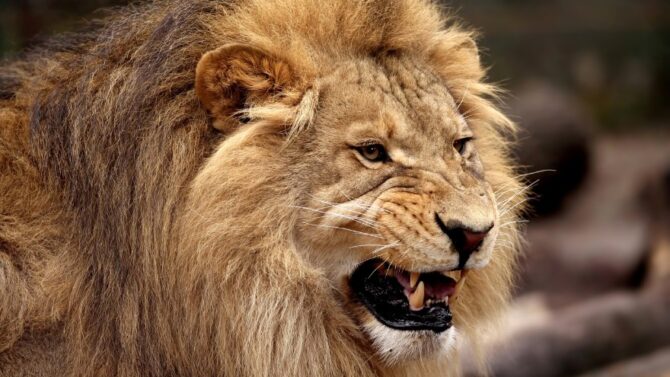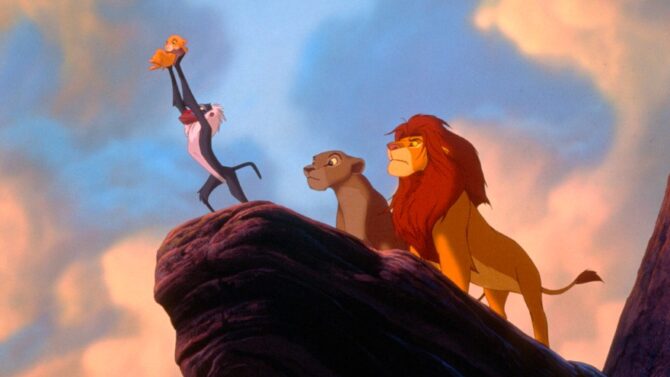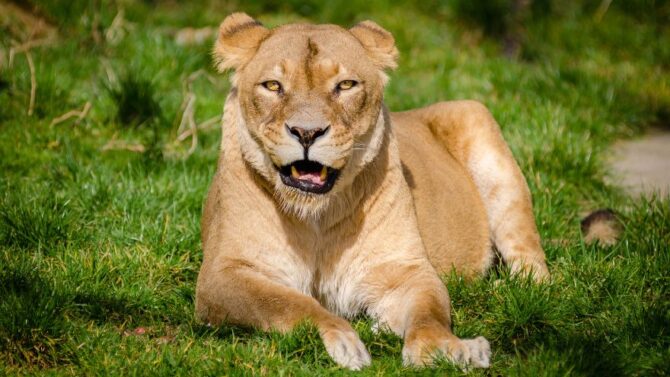The lion (Panthera leo) is a mammal of the Felidae (cat) family, and it is known as one of the biggest existing cats in our world today.
Commonly heralded as the king of animals, it is a symbol of pride for many. It is also popular thanks to movies and documentaries, though it is not as widespread as one would expect.
The lion is greatly feared by other animals and humans because of its fierce reputation and predatory skills.
The reputation is expected, but there are a lot of interesting facts about this huge cat, and it may not be as scary as it seems.
Scientific Classification
- Kingdom: Animalia
- Phylum: Chordata
- Class: Mammalia
- Order: Carnivora
- Family: Felidae
- Subfamily: Pantherinae
- Genus: Panthera
- Species: P. Leo
- Binomial Name: Panthera Leo
Characteristics
- Length: 4.7 to 8.2 ft
- Weight: 264 to 550 pounds
- Venom/Poison: No
- Skin Type: Fur
- Habitat: Grasslands, scrubs, open woodlands
- Range: Sub-saharan Africa
- Diet: Carnivore (Preferred meal: Zebra, warthog, antelope)
- Life span: 8 to 16 years
- Gestation Period: 102 to 112 days
- Age of sexual maturity: 2 to 3 years
- Age of weaning: 6 months
- Conservation status: Vulnerable
5 Interesting Facts About Lions
1. Lions are at risk
There used to be lions found in continents like Europe, Africa, Asia, and even in North America.
However, the range has since dwindled to only Africa and a few parts of Asia. There are currently two species still in existence: the African and the Asiatic.
What caused this loss of population? Poaching and habitat loss are the answers. Sadly, these animals are now considered vulnerable, according to the IUCN. There are only about 20,000 left on an estimate.
2. A group of lions is called a pride
Lions are social animals, and far from living alone, they live together in families. This is a unique trait as cats tend to be solitary.
A group of lions is called a pride and can contain 2 to 40 members. Animal groups are named after a virtue they possess, and for these animals, the virtue is their title as king of animals (or king of the jungle, as the case may be).
There are more females in a pride, so even a group of only females is called a pride. A group of males would be called a coalition.
3. They can stay for long without water
Lions need to drink a lot of water and eat, but they can cope without water for four days because they don’t need regular water.
They get water substance from their prey most time. They do need to eat every day and in a high quantities. Males eat 16 pounds while females eat 11 pounds.
Fortunately for them, they are apex predators in their habitats and hardly lack food. It’s always a problem if food gets scarce, especially if they live close to humans and their livestock. The latter could become endangered.
4. Lionesses are the hunters, lions are the protectors
People unfamiliar with how these animals live may imagine that the males are the prime hunters. However, that’s not the case. Lionesses are the primary hunters, and they have what it takes to hunt down and capture prey.
They are light on their feet and agile, and they usually hunt in groups (though it isn’t uncommon to see a lioness hunting alone.)
After they get their share, lions come to eat. The adult males eat first, then the females, then the cubs. The lions’ job is to protect the pride and the territory both from others and from strong predators (including humans).
5. Cubs are raised together (think about The Lion King)
There’s a form of camaraderie amongst lionesses, and that shows in their raising of cubs. Just as we saw in The Lion King with Simba and Nala, cubs get raised together by their mothers.
This is reinforced by the fact that mothers give birth at the same time. They take care of the cubs till the latter gets to ages two and three. Thereafter, the young males and females step out to fend for themselves.
A fun fact: While the common name for a baby lion is a cub, that’s not the only name used to describe these small ones. They can also be called lionets and whelps.
General Description
Lions are easily recognized, especially males. The latter comes with a mane that makes it appear elegant and distinguished, especially when compared to other cats.
They have a short, golden coat that is less spotty than that of relatives like the cheetah. The coat serves as a good camouflage for lionesses when they hunt, and their prey may not sight them till it is too late.
Another asset of this animal is its strong jaws. It has a bite force that is believed to be at 650 psi, though some argue that it is more than that. Added to the strong jaws are a mighty set of teeth, 30 in total.
The canines and other parts of the teeth are designed to be a carnivore’s arsenal.
For males, the mane is considered a part of the testosterone level. The color includes blonde, red, black, and brown.
There’s a special lion variant worth looking into, and that is the white lion. This is caused by a color mutation evident in other wild cats like the white tiger. However, while the latter is an albino, the white variant isn’t.
The color change is caused by recessive traits. These ones can be found more in zoos, though they have been slowly reintroduced into South Africa.
Distribution and Habitat
As we’ve mentioned, the historical range of this animal has reduced. While you could find them in many continents back then, now they are found mostly in Africa and a small part of Asia. Their number is reducing even in parts of Africa, as is evident in this report.
According to experts, lions were the most widespread animals other than humans 10,000 years ago. This has long changed, with only about 20,000 left in Africa, and only about 600 in Asia.
The drastic reduction happened after a couple of species got extinct. These are the American lion, the Cave lion, the Cape lion, and the Barbary lion.
The American species used to be found around the regions of the United States and Mexico. It used to be the largest lion species before it disappeared 12,000 years ago thanks to global climate change.
The Cave species was popular in all of Europe, and it extended to Asia and Alaska. It also went extinct around 12,000 years ago after the decline of the mammoth steppe.
The Cape species lived in South Africa and had a darker mane than that of many species today. It disappeared from its region in 1858.
The Barbary species was located in the Northern parts of Africa, specifically from Egypt to Morocco. It got extinct due to hunting activities.
Modern lions are very adaptable, living in different habitats like open woodlands, scrubs, and grasslands.
Diet
An apex predator at its best, the lion is a carnivore that hunts many animals in its habitats.
Its favorite prey seems to be antelopes, warthogs, and zebras, but it can prey on a host of other animals. It eats wildebeests, buffalo, giraffes, antelopes, and even monkeys.
Not only are these animals apex predators, but they are also opportunistic. They grab hold of what’s available and can steal the kill of another animal. Because they eat a lot, they’re always ready to hunt.
Lionesses do the hunting, and their group method is unlike other cats. This helps them take down animals that are bigger than them, and the rate of success when they hunt as a group is higher than when alone.
Lions hardly hunt, but take priority on eating. They do protect their pride, so they also pull their weight.
Humans can also count as prey for these hunters (though as we’ll also see, humans are their biggest threats too).
Due to their dwindling population, you might only see lions at zoos or parks, so attacks on humans are reduced. They’ll still do so, though, if given the chance.
Reproduction and Gestation Period
Lions get to sexual maturity at 2 to 3 years, during these ages both the male and female can reproduce. They don’t have a particular mating period but can mate at all times of the year.
The gestation period lasts for about four months, after which the lionesses give birth live. They can produce up to 6 offspring at a time. Lions are polygamous. The male can reproduce with different females and vice versa.
The cubs are born blind, which makes them very vulnerable to their immediate surrounding. This is why they depend on their mothers, and fortunately, lionesses have a motherly instinct.
They take care of their cubs and that of others in their pride. The cubs also have spots that help them camouflage while older ones go hunting.
The mortality rate amongst cubs is high. Their lives are cut short by animal attacks, starvation, and even infanticide.
Mothers feed their cubs for about 6 months with milk, and they start consuming meat during that period as well. However, they don’t start hunting till they are about a year old.
Predators and Threats
Though they are apex predators, lions are not impervious to threats. They do not spend every day looking out for predators like a rabbit would, but can also find themselves in danger.
Their first big enemies are humans. We both fear and admire these cats, so if someone isn’t hunting them out of fear, it’ll be as a form of a trophy.
Poaching is a big reason some species went extinct and the rest are low in number. The increase in urbanization also leads to habitat loss.
Of course, lions aren’t innocent either. There have been cases of them infiltrating villages to find food and the result is attack leading to injuries on both sides. A famous case is that of the Tsavo lions that reportedly attacked and killed over 100 railroad workers.
Another threat they face is big prey like elephants and giraffes. These animals aren’t predators, but they can defend themselves against lions, even killing them in the process. It usually takes a good number of lionesses to hunt these big animals.
Then, we have the threat that comes from other lions. A pride can invade another to conquer the territory, and males might kill the cubs of another to cut off the bloodline.
The final threat we have is that of diseases gotten from hyenas and other wild dogs. These kill lions just as much as other threats on our list.
Behavior
Lions are often portrayed as ferocious, proud hunters, but away from that image, there’s a lot more to this mammal.
Their social life as a pride marks them as different from other cat creatures. The pride often consists of 5 to 15 females, their cubs, and a few males (usually 1 to 3 in number).
The males mark their territories with urine, a trait many other animals have. This is a sign to deter other males from invading.
Of course, it doesn’t always work. Other males will attack, and they may either win or succeed. The males of any tribe have a lot of protecting work to do.
Females take care of hunting, and though they aren’t always successful in bringing back games, their cooperative nature does a lot of good. Males hardly hunt because they are slower, bigger, and not always able to lay an ambush.
A common behavior amongst these animals is the roar. Measuring up to 114 decibels, you can hear the sound from up to 5 miles away.
A roar from up close can damage a person’s ears, and this is possible because of their vocal folds. Lions use their roar to warn off others and to communicate with members of their pride.
Male vs Female
Amongst the cat family, lions are the only animals that are sexually dimorphic. We’ve already mentioned several differences in the preceding sections, but let’s highlight the main differences:
- Males have a long, flowing mane that females don’t have. Females look more like cheetahs and leopards, except for the spots.
- Males are generally bigger the females. While the males weigh between 330 and 570 pounds, the females come between 270 to 400.
- Females are more in a pride, but males have more priority in feeding. They eat first before females do.
- Females do the hunting, males do the protecting.
- Females are faster and hide easier than males.
- Females take care of the cubs. Males hardly do.
Frequently Asked Questions
Can lions and tigers mate?
As odd as it might sound, lions and tigers can mate. This doesn’t happen in the wild, however. It often occurs when both of them are in captivity. The mating often happens between a lion and a tiger, and the resultant offspring is a liger. Ligers are always very huge, combining the genes of both parent animals.
Are lions extinct?
Not all lions have gone extinct, but they are in a decline. The IUCN has listed them as vulnerable, with a range limited to Africa and Asia. Sadly, lions in countries like Nigeria are on the brink of extinction.
Can a lion be a pet?
Many have made attempts to domesticate the lion, but it’s futile ultimately. The lion is a wild animal and has a predatory instinct. No amount of domestication can take that away. Thus, they don’t make good pets.
Can a lion win against a tiger?
Both lions and tigers are heralded as kings, which begs the question: Who would win in a fight? There is no definite answer as these animals don’t cross paths, and it could end up as a game of chance. When Ancient Romans used to pit lions and tigers against themselves, either can emerge victorious.
Conclusion
They may be reduced, but lions won’t be easily forgotten! Still a highlight at zoos and parks, these animals retain the admiration and fear humans have for them.
Pride is indeed their virtue, and it isn’t a surprise these noble cats are called pride. We hope their population increases in the years to come.
